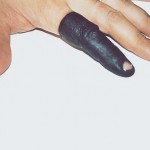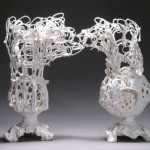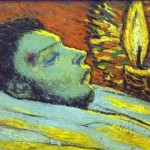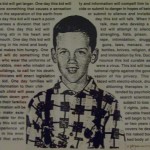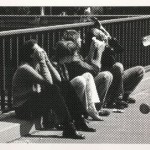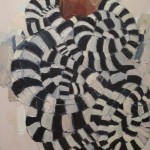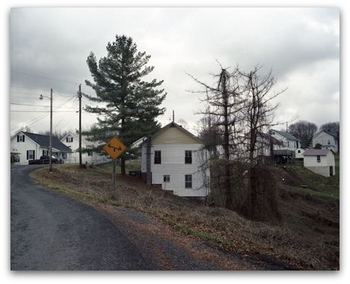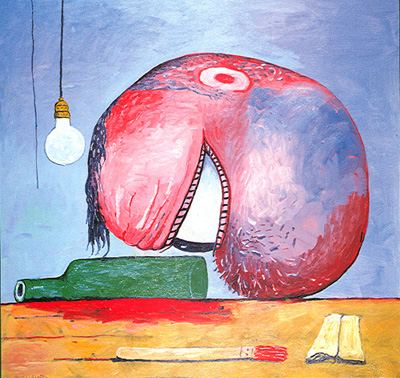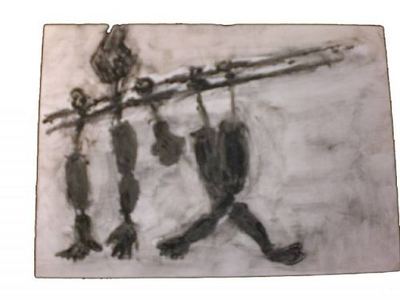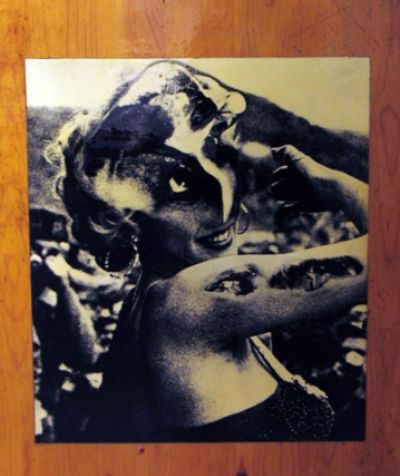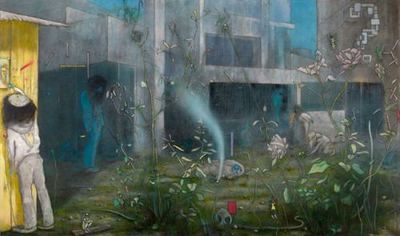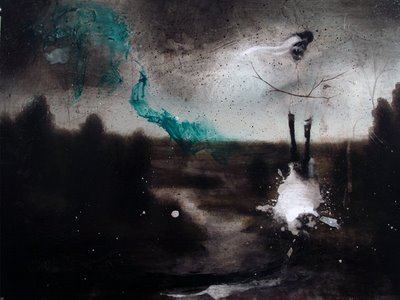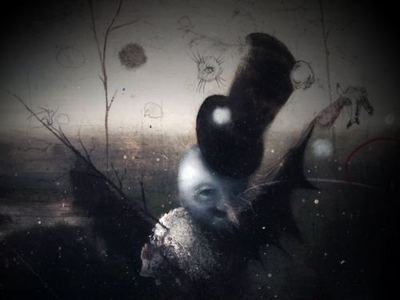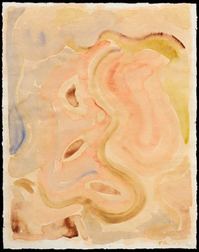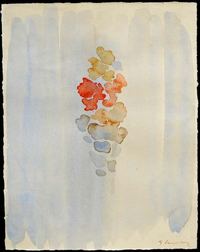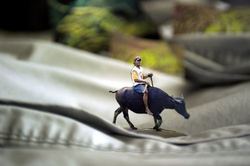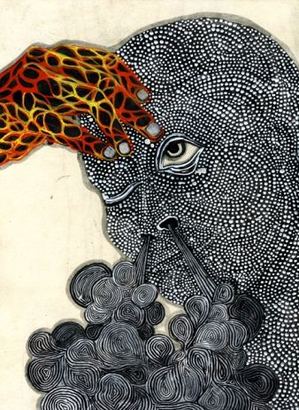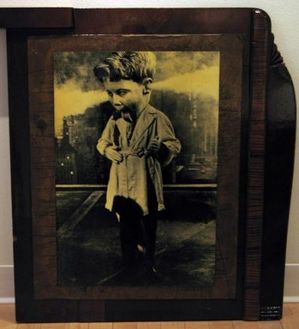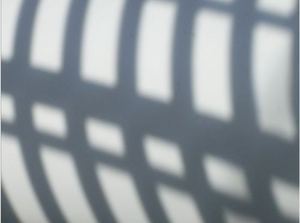Miner’s Camp, Jewell Ridge, VA (2006) Click to enlarge.
Main Content
Aristos: Delighted to disappoint you, Mr. Torres
About this post on Gala Bent, Louis Torres quoted from and queried:
“No matter how she crowds her space, nobody’s home…. Her drawings
appear to be waiting for you to leave, in order to disappear.”Please translate.
I responded:
There’s a mute, recessive quality to her drawings that comes close to threatening her form.
Because I realized I wasn’t connecting with him at all, I added:
I think of it as a good thing.
I was going for an improvisation rather than a review, a moment instead of a full-dress regalia. Torres, co-editor of Aristos, disapproves. Aristos passes out awards for art writing each year.
Briefly stated, (the Aristos awards) are given for objectivity in arts
criticism, scholarship, or
commentary. Such objectivity involves the recognition (usually
implicit) that art has a particular nature, and that the art of the
present necessarily bears a fundamental similarity to the art of the
past. Often, the resulting conclusion is that a work
regarded as art by experts is not art at all. The fullest explication
of the point of view underlying the awards is found in What
Art Is: The Esthetic Theory of Ayn Rand.
Ah, Ayn Rand. The high priestess of unregulated capitalism, the celebrant of selfishness, the enemy of community. I am delighted to disappoint you, Mr. Torres.
Governor Grizzly loves his bear
On vacation, Arnold Schwarzenegger ran into a bear and bought it.
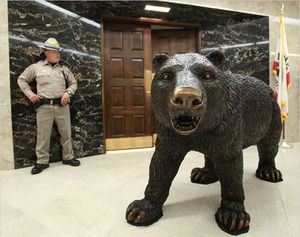 The New York Times had the story first, with the SF Chronicle trailing. It’s never good to trail a national paper on your local story. Those who think getting stomped on such a trivial matter doesn’t matter haven’t worked at a newspaper. A four-footed bronze animal blocking the entrance to the governor’s office qualifies as an event. The Chronicle should have had its paws all over it.
The New York Times had the story first, with the SF Chronicle trailing. It’s never good to trail a national paper on your local story. Those who think getting stomped on such a trivial matter doesn’t matter haven’t worked at a newspaper. A four-footed bronze animal blocking the entrance to the governor’s office qualifies as an event. The Chronicle should have had its paws all over it.
Jon Carroll’s piece is nice, but I wish the paper had sent its art critic, Kenneth Baker. Mr. Minimalism would not have been amused. When he rouses himself to lament, it is always worth reading.
Carroll the spoilsport mentioned the real problems real bears have in California. As metaphors and representations, however, they continue to thrive.
My favorite bear opens Theodore Roethke’s Four for Sir John Davies, a passage titled The Dance:
Is that dance slowing in the mind of man
That made him think the universe could hum?
The great wheel turns its axle when it can;
I need a place to sing, and dancing-room,
And I have made a promise to my ears
I’ll sing and whistle romping with the bears.For the are all my friends: I saw one slide
Down a steep hillside on a cake of ice, —
Or was that in a book? I think with pride:
A caged bear rarely does the same thing twice
In the same way: O watch his body sway!
This animal remembering to be gay.
I am also exceeding fond of Jeffry Mitchell‘s bears. If Roethke’s had sexual congress with Winnie the Pooh, Mitchell’s would be their issue.
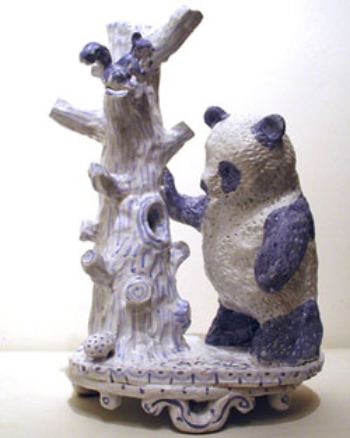
Contemporary painting and the 14th century – still in the mirror
If the polarities of art were considered in political terms, Obama would be classical (restrained, cerebral, detached) instead of expressionist (emotional, intuitive, physically engaged). Bush rose to neither occasion. With his irrationally sunny and
superficial certainties, he would be as out of place in the latter
tradition as the former.
(Francis Bacon, click images to enlarge.)
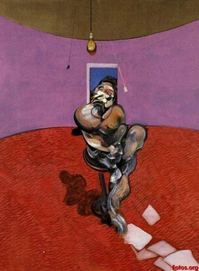 Nor would Bush have been at home in the Dark Ages. His privileged and tidy-minded version of the evangelical was unknown in the 14th century. Saying that century’s version of a spiritual aesthetic is notable in the age of Obama is not to link it to the stupidities of his predecessor.
Nor would Bush have been at home in the Dark Ages. His privileged and tidy-minded version of the evangelical was unknown in the 14th century. Saying that century’s version of a spiritual aesthetic is notable in the age of Obama is not to link it to the stupidities of his predecessor.
Belief is hardwired into temperament and capacity, not just experience. And yet with its ruinous temperature changes, unending wars, failed economies and corruption at the core of the Roman Catholic Church, the European 14th century serves as the model of a culture so decisive it overwhelms personal inclination.
What can be said of a world in which people crawled to church on bloodied knees along streets lined with stinking corpses to pray for the courage to kill the Jews? (See, Barbara Tuchman’s A Distant Mirror: The Calamitous 14th Century.)
That mirror continues to reflect darkly. In the aesthetic realm, this species of dark sight projects an inner light. It is not today’s dominant vision. There is no dominant vision, but it’s a force growing ever more prominent. Below, a few samples, not at all definitive.
1. Philip Guston 2. Susan Rothenberg 3. Joseph Mills 4.Nigel Cook and 5, 6 and 7. Anthony Pontius at Roq La Rue through May 2.
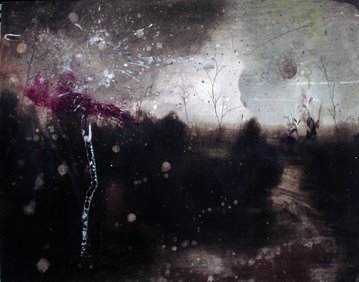
Li Wei: street sign
Gala Bent – May the force be with you
Gala Bent draws dense, dainty tableaus that make light work of heavy symbolism. Her heart’s in hallucinated oddities with silky, spatial connectives and small, bright bursts of color. No matter how she crowds her space, nobody’s home. She’s myth-minded but modest. Her drawings appear to be waiting for you to leave, in order to disappear.
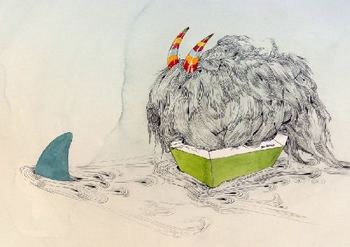 At Gallery4Culture till Friday.
At Gallery4Culture till Friday.
Susan Skilling – from Northwest muck to lovely light
Susan Skilling was raised on the lovely muck of the Northwest School’s color palette, those muted grounds seeded with light.
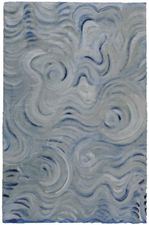 Hers isn’t a name that leaps to mind when talking about the region’s prominent artists.
Hers isn’t a name that leaps to mind when talking about the region’s prominent artists.
For decades she has labored in semi-obscurity, praised when she exhibits but prone to drop out of sight for years on end before surfacing again to startle those who see her work.
It’s classically Northwest in tonality and aspiration, using dim tones to seek celestial things in gouache or opaque watercolor on paper.
Forward momentum comes from pulses of purely abstract form, small shapes aspiring to be squares but distorted by the rhythm of the piece into more fluid configurations.
Skilling’s affinities also run toward the early American modernist Authur Dove. Like him she stakes out a quiet thing and fills it with air.
At Greg Kucera through May 16. Also at Kucera, Victoria Haven. (Another Bouncing Ball review of Haven’s show here.)
Stephanie Syjuco: a great back story
From James Harris, where her work is on view till May 2:
Stephanie Syjuco uses the tactics of bootlegging, reappropriation, and fictional fabrications to address issues of cultural biography, labor, and economic globalization…She constructed small cut-out dioramas taken from tourist photographs of the Philippines and placed them conspicuously throughout her apartment. She then photographed her living space as a personal travelogue….By examining and constructing objects with fictional identities and histories, the artist reveals a larger truth: that we constantly invent narratives about ourselves and about others.
She’s got it all – identity politics, race, the global economy, the shifting mirage of home base and a creative use of multiple media.
As Charles Mudede wrote about her 2005 exhibit at James Harris, these issues have legs. He praises her for not being
dazzled by the phantasmagoria of planetary capitalism but instead uses its physical and visual commodities as the very material (and subject) of her sculptures, photographs, and media installation.
I’d like to know who’s dazzled by that phantasmagoria, besides the heads of international corporations, none of whom are quite as confident as they once were, seeing that global capitalism is on the ropes.
Back to the art. It’s deeply illustrative of its content, which makes it feel like homework. Mudede appears to be in love with the artist’s politics. Art critics can be swayed by underdog efforts, but art doesn’t care. For its own reasons, it favors or ignores lunatics in asylums and painters paid by the court. All the good will in the world cannot turn a weak form into a strong one. I do not claim that Syjuco will never get to the genuine, just that she’s isn’t there yet.
Every breath you take
Circling the drain – from Robert Gober to Buster Simpson
Looking up from below, N. P. Thompson:
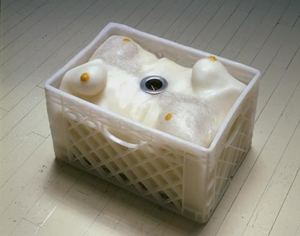 Harrison Higgs‘ drains are clogged..
Harrison Higgs‘ drains are clogged..
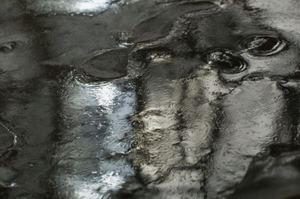 But Buster Simpson’s serve a useful purpose:
But Buster Simpson’s serve a useful purpose:



